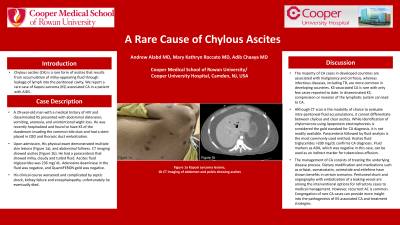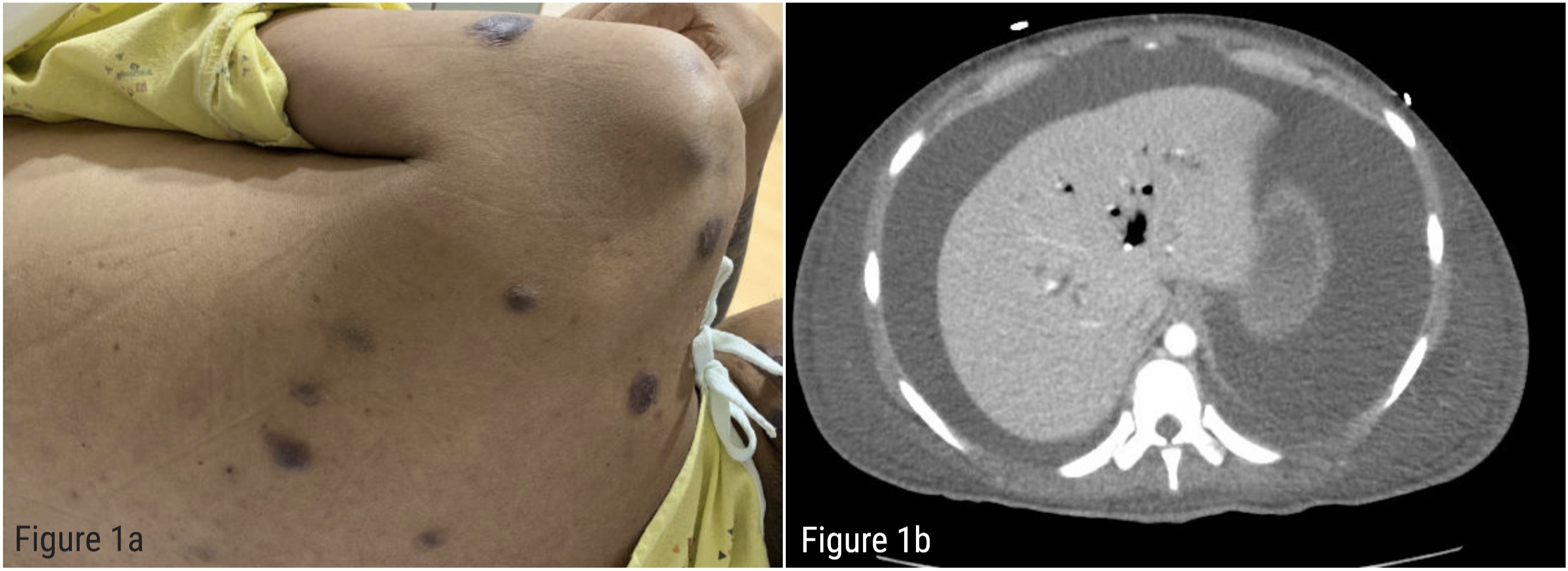Back


Poster Session A - Sunday Afternoon
Category: Stomach
A0724 - A Rare Cause of Chylous Ascites
Sunday, October 23, 2022
5:00 PM – 7:00 PM ET
Location: Crown Ballroom

Has Audio

Andrew Alabd, MD
Cooper University Hospital
Camden, NJ
Presenting Author(s)
Andrew Alabd, MD, Mary Kathryn Roccato, MD, Adib Chaaya, MD
Cooper University Hospital, Camden, NJ
Introduction: Chylous ascites (CA) is a rare form of ascites that results from accumulation of milky-appearing fluid through leakage of lymph into the peritoneal cavity. We report a rare case of Kaposi sarcoma (KS) associated CA in a patient with AIDS.
Case Description/Methods: A 29-year-old man with a medical history of HIV and disseminated KS presented with abdominal distension, vomiting, anorexia, and unintentional wight loss. He was recently hospitalized and found to have KS of the duodenum invading the common bile duct and had a stent placed in CBD and thoracic duct embolization. Upon admission, His physical exam demonstrated multiple skin lesions (Figure 1a), and abdominal fullness. CT imaging showed ascites (Figure 1b). He had a paracentesis that showed milky, cloudy and turbid fluid. Ascites fluid triglycerides was 236 mg/ dL. Adenosine deaminase in the fluid was negative, and quantiferon gold was negative. His clinical course worsened and complicated by septic shock, kidney failure and encephalopathy, unfortunately he eventually died.
Discussion: The majority of CA cases in developed countries are associated with malignancy and cirrhosis, whereas infectious diseases, including TB, are more common in developing countries. KS-associated CA is rare with only few cases reported to date. In disseminated KS, compression or invasion of the lymphatic system can lead to CA.
Although CT scan is the modality of choice to evaluate intra-peritoneal fluid accumulations, it cannot differentiate between chylous and clear ascites. While identification of chylomicrons using lipoprotein electrophoresis is considered the gold standard for CA diagnosis, it is not readily available. Paracentesis followed by fluid analysis is the most commonly used method. Ascites fluid triglycerides >200 mg/ dL confirms CA diagnosis. Fluid markers as ADA, which was negative in this case, can be used as an indirect marker for tuberculous effusion.
The management of CA consists of treating the underlying disease process. Dietary modification and medications such as orlistat, somatostatin, octreotide and etilefrine have shown benefits in certain scenarios. Peritoneal shunt and angiography with embolization of a leaking vessel are among the interventional options for refractory cases to medical management. However, recurrent AC is common. Congregation of rare CA cases can provide more insight into the pathogenesis of KS-associated CA and treatment strategies.

Disclosures:
Andrew Alabd, MD, Mary Kathryn Roccato, MD, Adib Chaaya, MD. A0724 - A Rare Cause of Chylous Ascites, ACG 2022 Annual Scientific Meeting Abstracts. Charlotte, NC: American College of Gastroenterology.
Cooper University Hospital, Camden, NJ
Introduction: Chylous ascites (CA) is a rare form of ascites that results from accumulation of milky-appearing fluid through leakage of lymph into the peritoneal cavity. We report a rare case of Kaposi sarcoma (KS) associated CA in a patient with AIDS.
Case Description/Methods: A 29-year-old man with a medical history of HIV and disseminated KS presented with abdominal distension, vomiting, anorexia, and unintentional wight loss. He was recently hospitalized and found to have KS of the duodenum invading the common bile duct and had a stent placed in CBD and thoracic duct embolization. Upon admission, His physical exam demonstrated multiple skin lesions (Figure 1a), and abdominal fullness. CT imaging showed ascites (Figure 1b). He had a paracentesis that showed milky, cloudy and turbid fluid. Ascites fluid triglycerides was 236 mg/ dL. Adenosine deaminase in the fluid was negative, and quantiferon gold was negative. His clinical course worsened and complicated by septic shock, kidney failure and encephalopathy, unfortunately he eventually died.
Discussion: The majority of CA cases in developed countries are associated with malignancy and cirrhosis, whereas infectious diseases, including TB, are more common in developing countries. KS-associated CA is rare with only few cases reported to date. In disseminated KS, compression or invasion of the lymphatic system can lead to CA.
Although CT scan is the modality of choice to evaluate intra-peritoneal fluid accumulations, it cannot differentiate between chylous and clear ascites. While identification of chylomicrons using lipoprotein electrophoresis is considered the gold standard for CA diagnosis, it is not readily available. Paracentesis followed by fluid analysis is the most commonly used method. Ascites fluid triglycerides >200 mg/ dL confirms CA diagnosis. Fluid markers as ADA, which was negative in this case, can be used as an indirect marker for tuberculous effusion.
The management of CA consists of treating the underlying disease process. Dietary modification and medications such as orlistat, somatostatin, octreotide and etilefrine have shown benefits in certain scenarios. Peritoneal shunt and angiography with embolization of a leaking vessel are among the interventional options for refractory cases to medical management. However, recurrent AC is common. Congregation of rare CA cases can provide more insight into the pathogenesis of KS-associated CA and treatment strategies.

Figure: Figure 1a Kaposi sarcoma lesions, 1b CT imaging of abdomen and pelvis showing ascites
Disclosures:
Andrew Alabd indicated no relevant financial relationships.
Mary Kathryn Roccato indicated no relevant financial relationships.
Adib Chaaya indicated no relevant financial relationships.
Andrew Alabd, MD, Mary Kathryn Roccato, MD, Adib Chaaya, MD. A0724 - A Rare Cause of Chylous Ascites, ACG 2022 Annual Scientific Meeting Abstracts. Charlotte, NC: American College of Gastroenterology.
